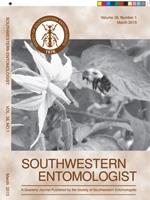The blackmargined aphid, Monellia caryella (Fitch), was studied on three cultivars, ‘Cheyenne’, ‘Kiowa’, and ‘Pawnee’, of pecan, Carya illinoinensis (Wangenh.) K. Koch, in the field. Abundance of aphids and natural enemies (lacewings, ladybird beetles, and spiders) was determined twice weekly by directly inspecting foliage on each pecan variety during the summers of 2005 and 2006. Water-sensitive cards were used to measure honeydew deposited. Aphid phenologies were similar among pecan cultivars; however, Cheyenne supported more aphids than did Kiowa or Pawnee. Honeydew production was directly correlated with aphid abundance. Abundance of natural enemies increased during initial stages of aphid outbreak on all pecan cultivars, and the asymptote reached on Cheyenne exceeded the action level of 25 aphids per leaf. Cheyenne had a lower natural enemy-to-aphid ratio than did the other cultivars, indicating that the functional response of natural enemies to increased aphid abundance was exhausted sooner on Cheyenne than on other cultivars where aphid abundance did not exceed the action level. Honeydew seems to be an attractant for natural enemies, and cost-benefit was calculated to quantify the loss of photosynthates to aphids versus the gain in natural enemies on each pecan cultivar. Cheyenne was the least efficient of the three cultivars in the utilization of this defense mechanism. The energy drain per hectare was calculated using aphid density and by measuring honeydew; data showed the energy drain on Cheyenne was 4–8 fold greater than that on Kiowa or Pawnee by using either method. Conversions of energy drain estimates to nut-equivalents indicated Cheyenne suffered economic damage that warranted treatment whereas Kiowa and Pawnee did not. These results suggested that moderately abundant blackmargined aphids efficiently attracted natural enemies with little risk of economic damage to the crop.
How to translate text using browser tools
1 March 2013
Blackmargined Aphid (Monellia caryella (Fitch); Hemiptera: Aphididae) Honeydew Production in Pecan and Implications for Managing the Pecan Aphid Complex in Texas
Jessica Honaker,
Sarah Skrivanek,
Juan Lopez,
Dan Martin,
Leo Lombardini,
L. J. Grauke,
Marvin Harris
ACCESS THE FULL ARTICLE

Southwestern Entomologist
Vol. 38 • No. 1
March 2013
Vol. 38 • No. 1
March 2013




